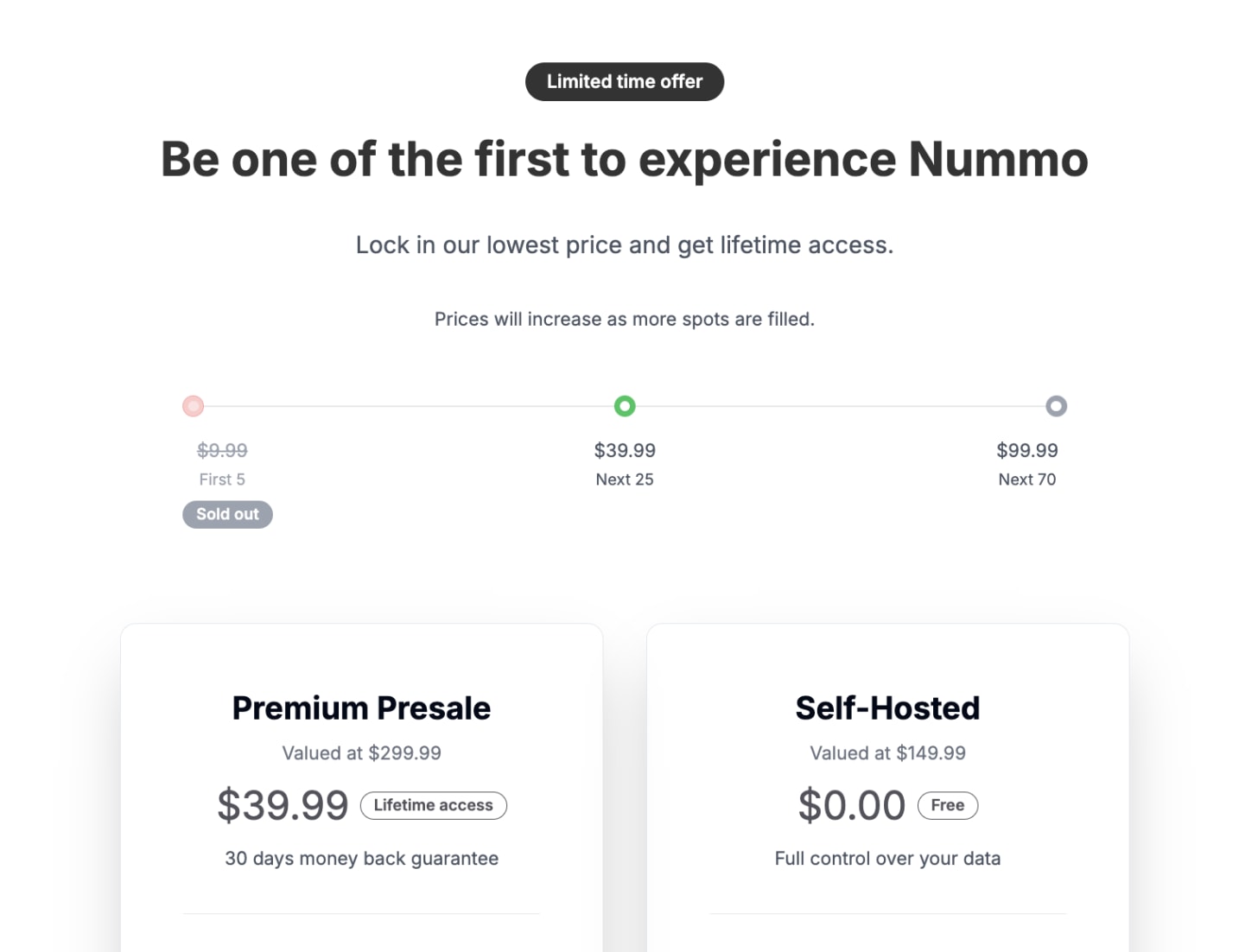5 lessons learned from pre-launching a SaaS
"Perfection is achieved, not when there is nothing more to add, but when there is nothing left to take away." — Antoine de Saint-Exupéry
Two months ago I pre-launched Nummo and so far it’s made almost $500 in profit.
I say pre-launch because the paid version isn’t live. People so far have paid for a promise, which makes me really happy and tells me I’m onto something.
The process has been as challenging as fulfilling, but overall it’s been incredibly instructive. I’m at a point where I know I’m building something valuable, but it’s still not ready for people to use it.
Here are 5 lessons I wish I knew before starting out.
1. Going from 0 to 1 is harder than from 1 to 10
Most people don’t make any money with online businesses. Successful founders make it sound easy, but $0 revenue is the natural state of any budding online venture. This is the reality for many SaaS founders.
The fact that Nummo is making > $0 before it’s even live speaks volumes about it.
If you’re building something and haven’t got any sales in 2-4 weeks, maybe it’s time to pivot.
2. Sell first, build later
Engineers will work on something for months or even years to then find out no one wants to use their product. My favorite way to avoid this is doing pre-sales. By pre-sales I mean actually selling something that is not ready, not getting users to say they will pay.
For Nummo I built a raw live demo and a simple landing page with a Stripe payment link.
I got 6 pre-sales in 36h.
The first sale came only 1 hour after I published the landing page. When I saw it I thought there was a bug on Stripe dashboard.
“What? How come someone’s paid already?” — I wondered in disbelief.
Then I checked my email and it wasn’t a bug. It was my first sale ever, for something that I had built from scratch.
Now I can focus on developing the product knowing people want it.
3. Building software solo is really hard
Some people say building software has become really easy with AI, but that’s simply not true for complex products like accounting software. AI is helpful to kickstart a simple project and get a quick prototype ready. But for bigger projects humans have to step in and handle most of the work.
So you’re pretty much on your own with thousands of lines of code, different integrations, frontend and backend, and multiple repositories. You can automate some plumbing, but the time you spend automating stuff, you don’t build the actual product.
Overall it’s full of tradeoffs and difficult decisions, but it’s incredibly rewarding. I’ve learned more about software engineering in the last 6 months on my own than in the previous 5 years working as a data engineer.
If you’re thinking about starting to develop something, don’t underestimate the technical complexity, especially if you don’t have a team.
4. Behavioral economics helps you make more sales
Marketing is applied behavioral economics. Anchoring, scarcity, social proof… All of those concepts aren’t just theory. They work. Here’s my pricing section, so you can see what I’m talking about.
Be one of the first to experience Nummo → Makes you feel part of something exclusive.
Limited spots and increasing price → This is scarcity + urgency. It makes you act now.
First 5 tier sold out → Creates FOMO.
Valued at $299.99, but you can buy it for $39.99 → Classic anchoring — and I’m not even lying about the value.
30 day money back guarantee → Completely de-risks the purchase. You can buy and get your money back if you don’t like it.
Free self-hosted version → builds goodwill and trust.
5. A great product beats marketing
Marketing is useless without a good product.
The product is the signal, and marketing is the amplifier. If your product is bad, marketing just amplifies how bad it is. If your product is great, however, you’ll get word-of-mouth and organic discovery, without even doing marketing.
I know Nummo is great because customers have said so. Finance professionals have secured their subscription and told me it’s ‘amazingly good’. I’ve poured my soul into building something great. It feels more like craftsmanship than cold, aseptic production.
If your product is great, you’ll know it because people will be naturally drawn to it. It won’t feel like fighting for attention and sales, but more like helping people discover it and fall in love with it.
Bonus: a little backstory
I’m really sensitive to beauty and I crave simplicity in everything I do. Nummo is a reflection of that. It’s something that I had in mind since last year, when I started to dabble in plain text accounting. The exact layout and design existed in my mind long before I brought it into reality.
The main inspiration comes from two sources: Workflowy and the current options of accounting software.
Workflowy is a notes app that is underrated. It allows you to create notes within notes, within notes… Basically a nested note structure without limits.
And that’s pretty much it. Simple, but extremely powerful.
So I applied the same concept to accounting books:
In Nummo you can create as many accounts and sub-accounts as you want. For example, if you run an e-commerce, you can create an account for every product you sell, so you can break down the costs and revenue per product.
In Nummo you can have an account per product:
Revenue / E-commerce / Product A
Revenue / E-commerce / Product B
In traditional accounting you just have a ‘Sales’ account that encompasses everything, and you miss out on valuable insights.
This is a game changer.
The second source of inspiration are current accounting software solutions. They’re horrible. As someone who cares about UX, I couldn’t get myself to use them. And I’m not alone. Everyone hates QuickBooks, but everyone keeps on using it.
It’s a huge opportunity and Nummo is poised to embrace it.






